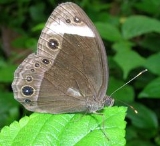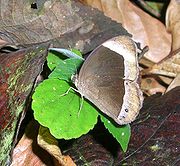
Mycalesis anaxias
Encyclopedia
The White-bar Bushbrown (Mycalesis anaxias) is a species of satyrid
butterfly found in South
and Southeast Asia
. In South Asia, it inhabits Sikkim
, eastwards through the hill-ranges to Assam
, Cachar, Myanmar
and Tenasserim. Also in Southern India, in the Nilgiris
and Travancore
.
 Wet-season form: male and female: Upperside dull van dyke-brown, paler in the female; subterminal and terminal fine lines on both fore and hind wings fulvescent: cilia brown. Fore wing with an oblique white preapical short band not quite reaching either the costa or the termen. Underside : fore wing: basal area up to the white band, and in a transverse line from lower end of band to dorsum, blackish brown ; terminal margin beyond broadly paler brown; a white-centred fulvous-ringed black ocellus in interspace 2, and two preapical, smaller similar ocelli, followed by a very sinuous subterminal and a straighter terminal dark brown line. Hind wing: basal two-thirds blackish brown, terminal border broadly paler, bearing normally seven ocelli similar to those on the fore wing, and subterminal and terminal dark brown lines.
Wet-season form: male and female: Upperside dull van dyke-brown, paler in the female; subterminal and terminal fine lines on both fore and hind wings fulvescent: cilia brown. Fore wing with an oblique white preapical short band not quite reaching either the costa or the termen. Underside : fore wing: basal area up to the white band, and in a transverse line from lower end of band to dorsum, blackish brown ; terminal margin beyond broadly paler brown; a white-centred fulvous-ringed black ocellus in interspace 2, and two preapical, smaller similar ocelli, followed by a very sinuous subterminal and a straighter terminal dark brown line. Hind wing: basal two-thirds blackish brown, terminal border broadly paler, bearing normally seven ocelli similar to those on the fore wing, and subterminal and terminal dark brown lines.
Dry-season form.— Upperside as in the wet-season form. Underside differs in the ocelli being indistinct or absent, and the subterminal and terminal dark lines on both fore and hind wing absent or very faint; the terminal margins are broadly rufescent brown, fading inwardly into lilacine, the oblique white bar on the fore wing outwardly diffuse- Antennae, head, thorax and abdomen dark brown; the antennae ochraceous towards apex.
Wingspan: 51–60 mm. Male sex-mark in form 1.
Satyrinae
Satyrinae, the satyrines or satyrids, commonly known as the Browns, is a subfamily of the Nymphalidae . They were formerly considered a distinct family, Satyridae. This group contains nearly half of the known diversity of brush-footed butterflies...
butterfly found in South
South Asia
South Asia, also known as Southern Asia, is the southern region of the Asian continent, which comprises the sub-Himalayan countries and, for some authorities , also includes the adjoining countries to the west and the east...
and Southeast Asia
Southeast Asia
Southeast Asia, South-East Asia, South East Asia or Southeastern Asia is a subregion of Asia, consisting of the countries that are geographically south of China, east of India, west of New Guinea and north of Australia. The region lies on the intersection of geological plates, with heavy seismic...
. In South Asia, it inhabits Sikkim
Sikkim
Sikkim is a landlocked Indian state nestled in the Himalayan mountains...
, eastwards through the hill-ranges to Assam
Assam
Assam , also, rarely, Assam Valley and formerly the Assam Province , is a northeastern state of India and is one of the most culturally and geographically distinct regions of the country...
, Cachar, Myanmar
Myanmar
Burma , officially the Republic of the Union of Myanmar , is a country in Southeast Asia. Burma is bordered by China on the northeast, Laos on the east, Thailand on the southeast, Bangladesh on the west, India on the northwest, the Bay of Bengal to the southwest, and the Andaman Sea on the south....
and Tenasserim. Also in Southern India, in the Nilgiris
Nilgiris (mountains)
The Nilgiri , often referred to as the Nilgiri Hills, are a range of mountains with at least 24 peaks above , in the westernmost part of Tamil Nadu state at the junction of Karnataka and Kerala states in Southern India...
and Travancore
Travancore
Kingdom of Travancore was a former Hindu feudal kingdom and Indian Princely State with its capital at Padmanabhapuram or Trivandrum ruled by the Travancore Royal Family. The Kingdom of Travancore comprised most of modern day southern Kerala, Kanyakumari district, and the southernmost parts of...
.
Description
- See glossary of Lepidopteran termsGlossary of Lepidopteran termsThis glossary describes the terms used in the formal descriptions of insect species, jargon used mostly by professionals or entomologist....
for terminology used

Dry-season form.— Upperside as in the wet-season form. Underside differs in the ocelli being indistinct or absent, and the subterminal and terminal dark lines on both fore and hind wing absent or very faint; the terminal margins are broadly rufescent brown, fading inwardly into lilacine, the oblique white bar on the fore wing outwardly diffuse- Antennae, head, thorax and abdomen dark brown; the antennae ochraceous towards apex.
Wingspan: 51–60 mm. Male sex-mark in form 1.

